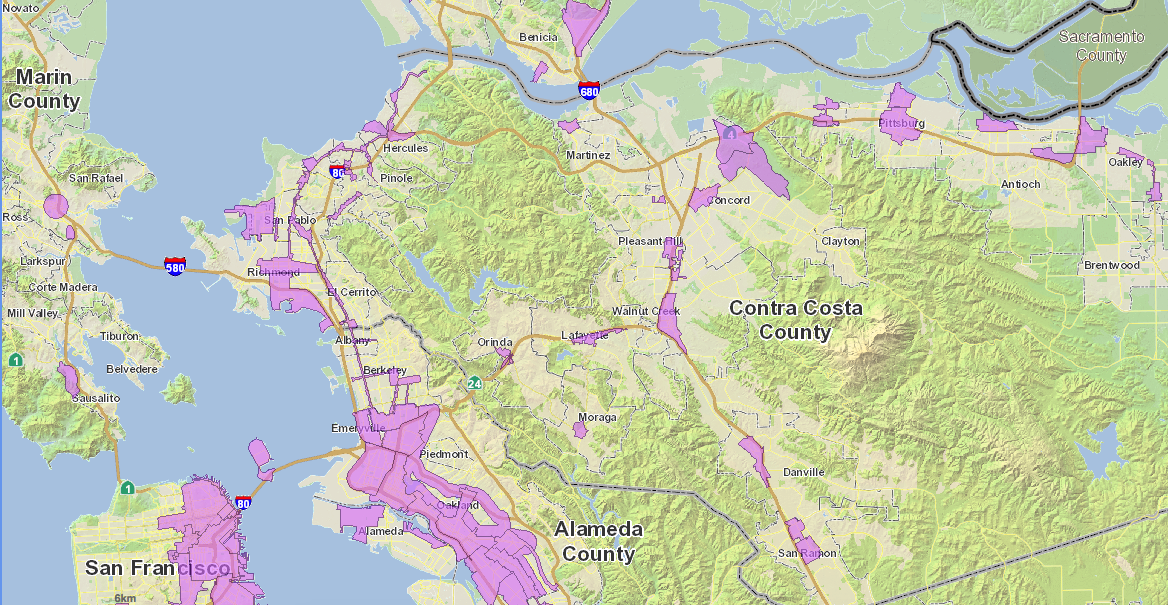By Julia Foote
How we build our cities and towns has a profound effect on the causes and impacts of climate change. The Sierra Club believes that an essential strategy for reducing urban carbon emissions is supporting dense, mixed-use communities and land uses that prioritize walking, biking/scooting or transit to meet daily transportation needs. We must also balance jobs and housing within the region to alleviate the housing crisis and ensure that people can live closer to where they work, cutting down long commutes.
In the Bay Area we have “Priority Development Areas,” or PDAs, as a key strategy to develop our region in the most sustainable manner. PDAs are existing neighborhoods that are served by public transit and have been locally identified and approved as appropriate for additional, compact development.
PDAs must be:
-
Within an existing community
-
Within a half-mile of frequent transit
-
In an area planned for future housing and job growth
PDAs are expected to accommodate 78 percent of projected new housing production (over 500,000 units) and 62 percent of employment growth (almost 700,000 jobs) in the Bay Area through the year 2040. More than 70 city and county governments have voluntarily designated some 170 locations around the Bay Area as PDAs. The PDA strategy aims to minimize sprawl development in our green spaces and maximize growth in transit-rich communities, which will help reduce driving and driving-related greenhouse gas emissions.
In the Bay Area, PDAs have the potential to help us implement and achieve the Sierra Club’s infill strategy. PDAs serve as a development management tool to define the areas of public investment in urban infrastructure to serve dense housing, jobs and services, prevent environmentally and fiscally unsustainable development, and protect farmland, critical habitat and open space.
Sierra Club’s support for successful PDAs is a natural corollary to our opposition to sprawl, which promotes automobile dependence, destroys natural ecosystems, separates people from each other, increases social inequity, reduces economic security and increases carbon emissions.
Help Your Local PDA Be Successful:
We want to ensure that PDAs are successful in their goal of reducing emissions, while prioritizing equity in accordance with the Sierra Club’s infill policy. To that end, we offer the following guidelines for Bay Area PDAs:
-
PDAs should not only be dense, but also inclusive, so that fewer people will have to “drive till they qualify” for housing financing — preventing even more emissions;
-
PDAs should be designed to make neighborhoods walkable. Neighborhoods in the city and metropolitan contexts should be linked together by convenient, high-quality transit prioritized in regional, state and national transportation expenditure plans;
-
PDAs should be zoned for dense/multi-family/mixed-use development in order to support walkability and reduce emissions and waste;
-
All land use plans should identify opportunities for adapting to climate change and build resilience across communities and physical infrastructure;
-
PDAs should reject land use policies that are designed to separate people by class and race and should be developed in such a way to ensure that planning, housing and development practices don’t reinforce those inequitable and racist outcomes; and
-
PDAs should address past and ongoing inequity in the communities and neighborhoods most damaged by it and to fully engage the stakeholders of such communities.
Is there a PDA in your community? Take these talking points to your city and county officials and make sure your local PDA helps ensure the most sustainable, equitable growth possible.
Background:
PDAs are key to making the Sustainable Communities Strategy required by California Senate Bill 375 a success. SB375 focuses on incentivizing regional and local planning and building in ways that bring people and destinations closer together, with low-carbon, alternative and convenient ways to get around. It requires regional metropolitan planning organizations in California to develop long-range plans, or Sustainable Communities Strategies, or long-range plans, which align transportation, housing, and land-use decisions toward achieving greenhouse gas emissions reduction targets set by the California Air Resources Board.

Find an updated map of Priority Development Areas in the Bay Area online here.